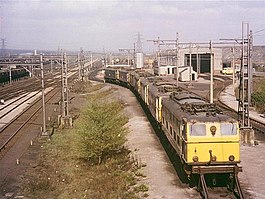Wath marshalling yard
| Wath marshalling yard | |
|---|---|

Wath Railway Depot and Yards
|
|
| Location | |
| Place | Wath-upon-Dearne |
| Area | Rotherham |
| Coordinates | 53°30′36″N 1°21′15″W / 53.510°N 1.3542°WCoordinates: 53°30′36″N 1°21′15″W / 53.510°N 1.3542°W |
| Grid reference | SE428017 |
| Operations | |
| History | |
| 1907 | opened |
| 1988 | closed |
| Disused railway stations in the United Kingdom | |
| Closed railway stations in Britain A B C D–F G H–J K–L M–O P–R S T–V W–Z |
|
|
|
|
Wath marshalling yard, also known as Wath concentration yard, was a large railway marshalling yard specifically designed for the concentration of coal traffic. It was set at the heart of the South Yorkshire Coalfield, at Wath-upon-Dearne, approximately halfway between Barnsley and Doncaster, in the United Kingdom. It opened in 1907 and closed in 1988.
The idea of a yard for the concentration of coal traffic developed following a visit by the Great Central Railway's General Manager, Sam Fay (later Sir Sam Fay) to the United States. it was built by Logan and Hemingway, a contractor regularly used by the Great Central Railway and the Manchester, Sheffield and Lincolnshire Railway before them, and opened in August 1907.
At this time a significant amount of rail-borne coal traffic was wagon-load. Customers would order coal direct from individual collieries, which would utilise the railways to deliver the coal in the colliery's own four-wheel wagons that usually carried between 12 and 16 tons of coal. These customers could be anything from a domestic coal merchant ordering a single wagon of coal to be delivered to a station goods yard for local delivery, up to rail-connected industry that would consume many thousands of tons of coal a month. All this generated a very complex pattern of rail traffic from the 45 collieries that were working within a ten-mile radius of Wath.
The purpose of the yard was to make this traffic more efficient by concentrating the marshalling of the wagons of coal from the local collieries in a central position. Coal wagons were "tripped" in local trains from each colliery to the yard, then sorted into longer distance trains which would deliver to a marshalling yard near the customer, from where the wagons would again be re-sorted into new local "trip" trains that delivered the wagons to their individual destinations. Throughout its lifetime, the yard handled loaded and empty coal and coke wagons almost to the exclusion of other traffic.
...
Wikipedia
